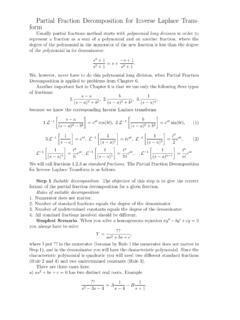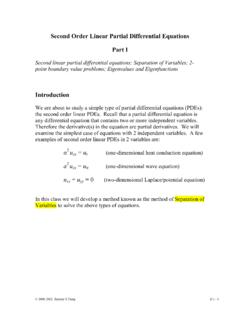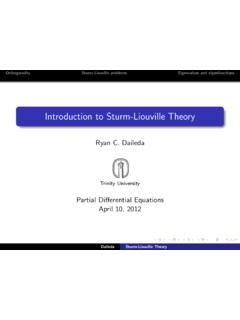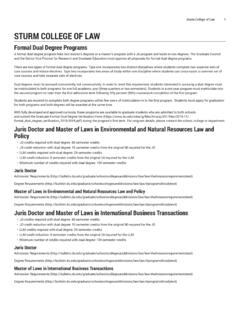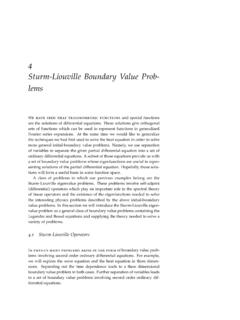Transcription of MATH 412 Fourier Series and PDE- Spring 2010 SOLUTIONS …
1 MATH 412 Fourier Series and PDE- Spring 2010 SOLUTIONS to homework 5 Problem 1.(a):Solve the following sturm -Liouville problem((xu ) + xu= 01< x < eu(1) =u (e) = 0.(b):Show directly that the eigenfunctions are orthogonal with respect to thesuitable inner product. What is the length of an eigenfunction with respectto the norm related to this inner product?Solution:(a) Multiplying byxboth sides of the above equation we get(1)x2u +xu + u= indicial equation of this equation iss2+ = <0, thes2+ = 0has twodistinct real solutionss1= ands2= . In this case the general solution of(1) is given byu(x) =Axs1+ Then0 =u(1) =A+Bso thatA= Band,sinceu (x) =s1 Axs1 1+s2 Bxs2 1,0 =u (e) =Ae[s1es1 s2es2]. IfA6= 0, thens1es1=s2es2. Sinces1>0ands2<0and the exponential function is positive, theequalitys1es1=s2es2is impossible. So,A= 0. ThenB= 0and we get a trivialsolution. If = 0, thens2= 0has a double solutionss1=s2= 0.)
2 In this case thegeneral equation of (1) is equal tou(x) =A+Blnx. Then0 =u(1) =Aand sinceu (x) =B/x,0 =u (e) =B. Again the problem has a trivial solution. If >0,then the equations2= , has two complex solutionss1= i ands2=i .In this case the general solution of (1) isu(x) =Acos( lnx) +Bsin( lnx).Then0 =u(1) =Aand sinceu (x) =B cos( lnx)x, it follows that0 =u (e) =B cos( )e. IfB= 0, we get a trivial solution and forB6= 0, we getcos = this we find that the problem has a nontrivial solution if =(2n+1) 2forn 0. Hence The eigenvalues and the corresponding eigenfunctions are n= (2n+ 1) 2 2,un(x) = sin (2n+ 1) lnx2 ,for alln 0.(b) The eigenfunctions are orthogonal with respect to the inner producthf, gir=Re1f(x)g(x)1xdx.(To get(r(x) = 1/xlook at the original equation.) Using substi-tutiony= 2lnx, we find forn6=m,Ze1sin (2n+ 1) lnx2 sin (2m+ 1) lnx2 1xdx=2 Z /20sin((2n+ 1)y) sin((2m+ 1)y)dy=1 Z /20cos(2(n m)y) 1 Z /20cos(2(n+m)y)=12(n m) sin 2(n m)y /20 12(n+m) sin 2(n+m)y /20= find the length ofuncalculatekunk2r=Ze1sin2 (2n+ 1) lnx2 1xdx=2 Z /20sin2((2n+ 1)y)dy=1 Z /20[1 cos(2(2n+ 1)y)dy=12 1 Z /20cos(2(2n+ 1)y)dy=12 12(2n+ 1) sin(2(2n+ 1)y) /20= ,kunkr=q12for alln 2.)]
3 (a):Consider the following sturm -Liouville problem((x2v ) + v= 01< x < bv(1) =u(b) = 0whereb >1. Find the eigenvalues and eigenfunctions of the problem.(b):Show directly that the eigenfunctions are orthogonal with respect tothe suitable inner product. What is the length of the eigenfunctions withrespect to the norm related to this inner product?Solution:(a) The equation is equivalent to(2)x2v + 2xv + v= indicial equation has the forms(s 1) + 2s+ =s2+s+ = , s2bezeros of this equation. Ifs1, s2are distinct real SOLUTIONS , then the general solutionof (2) is of the formu(x) =Axs1+ the boundary conditions we get0 =v(1) =A+Band0 =Abs1+Bbs2=A[bs1 bs2]. Sinces16=s2,A= 0so thatalsoB= 0. Ifs1=s2, thenv(x) =Axs1+Bxs1lnx. Hence0 =v(1) =Aand0 =v(b) =Bbs2lnbso thatB= 0sinceb >1. Ifs1, s2are complex zeros, then1 4 <0ands1= +i = 12 i 4 12ands2= i = 12 + 4 general solution in this case is equal tov(x) =Ax cos( lnx)+Bx sin( lnx).)
4 Hence0 =v(1) =Aand0 =v(b) =Be bsin( lnb)which implies thatsin( lnb) =0. w So, n=n /lnbforn 1. Since n= 4 n 1/2, the eigenvalues and thecorresponding eigenfunctions are n=n lnb+14,vn(x) =x 1/2sinn lnxlnb, n 1.(b) Substitutingy= lnxlnb, we find forn6=m,hvn, vmi=Zb1sin n lnxlnb sin m lnxlnb 1xdx=lnb Z 0sin(ny) sin(my)dy= 0,and forn=m,kvnk2=hvn, vni=Zb1sin2n lnxlnbdx=lnb Z 0sin2(ny)dy=lnb2 Z 0(1 cos 2ny)dy=lnb2 x sin 2ny2ny 0= the length of the eigenfunctionvnis equal tokvnk=rlnb2,n the method of separation of variables to solve thetelegraphicequationwith the initial boundary conditions utt+ut uxx= 0,0< x <2, t >0u(0, t) =u(2, t) = 0,t 0u(x,0) = 0,0 x 2ut(x,0) =x,0 x :Writeu(x, t) =X(x)T(t). ThenT (t)T(t)+T (t)T(t)=X (x)X(x)= for some constant . This gives to equations(3)T +T + T= 0and(4)X + X= 0X(0) =X(2) = 0 The problem (4) has the following eigenvalues and corresponding eigenfunctions n= n 2 2,Xn(x) = sin n x2 , n given n, we have to solve (3).
5 It characteristic equation iss2+s+ s= 4 n= 1 n2 2<0for alln 1, the characteristic equation has twocomplex solutionss1= 12 i n2ands2= 12+i n2where n=n2 2 the solutionsTnof (3) with = nis given byTn(t) =Ane t/2cos nt2+Bne t/2sin nt2and with the product solutionu(n(x, t) =Xn(x)Tn(x), the proposed solution forthe problem isu(x, t) =Xn 1un(x, t) =e t/2Xn 1 Ancos nt2+Bnsin nt2 sin n x2 .Att= 0,0 =u(x,0) =e t/2Xn 1 Ansin n x2 so thatAn= 0for alln 1. Differentiatinguwith respect totatt= 0, we getx=ut(x,0) =Xn 1 n2 Bnsin n x2 form which we obtain n2Bn=22Z20xsin n x2 ,n above integral is equal toZ20xsin n x2 dx= 2xcosn x2n 20+2n Z20cosn x2dx= 4( 1)nn +4n2 2 sin n x2 20=4( 1)n+1n .HenceBn=8( 1)n+1n n andu(x, t) =8e t/2 Xn 11n n sin nt2sin n x2 .Problem the method of separation of variables to solve ut=uxx 4u0< x < , t >0ux(0, t) =u( , t) = 0t 0u(x,0) =x2 20 x Is the solution found above a classical solution?)
6 Solution:Writeu(x, t) =X(x)T(t). ThenT (t)T(t)+ 4 =X (x)X(x)= .This gives two equations(5)T + (4 + )T= 0and(6)X + X= 0X (0) =X( ) = 0 For <0, the general solution isX(x) =Acosh x+Bsinh x. SinceX (x) = [Asinh x+Bcosh x], it follows that0 =X (0) =Band0 =X( ) =Acosh so that alsoA= 0. If = 0, thenX(x) =Ax+Band the boundary conditions imply thatA=B= 0. IfA >0, thenX(x) =Acos x+Bsin x. SinceX (x) = [ Asin x+Bcos x], the boundaryconditions imply that0 =X (0) = Bso thatB= 0and0 =X( ) =Acos .To get the nontrivial solution we needB6= 0andcos = 0. This is the case when = 2n+12 2for alln 0. So, the eigenvalues and corresponding eigenfunctionsare n= 2n+ 12 2,Xn(x) = cos(2n+ 1)x2,for alln given n, the solution of (5) isTn(t) =e 4te product solutionun(x, t) =Xn(x)Tn(t) =e 4te ntcos(2n+1)x2so that theformal solution of the problem isu(x, t) =e 4tXn 1 Ane ntcos(2n+ 1) 0,x2 2=u(x,0) =Xn 0 Ancos(2n+ 1) ,An=2 Z 0(x2 2) cos(2n+ 1) above integral is equal to2 Z 0(x2 2) cos(2n+ 1)x2=2 Z 0x2cos(2n+ 1)x2 2 Z 0cos(2n+ 1) first integral is equal to2 Z 0x2cos(2n+ 1)x2=2 2x2sin(2n+1)x2(2n+ 1) 0 4(2n+ 1) Z 0xsin(2n+ 1)x2=4 2n+ 1sin(2n+ 1) 2+4(2n+ 1) 2xcos(2n+1)x2(2n+ 1) 0 8(2n+ 1)2 Z 0cos(2n+ 1)x2=4 2n+ 1sin(2n+ 1) 2+8(2n+ 1)2cos(2n+ 1) 2 16(2n+ 1)3 sin(2n+ 1) 2=4 ( 1)n2n+ 1 16( 1)n(2n+ 1)3.
7 The second integral is equal to2 Z 0cos(2n+ 1)x2=4 2n+ 1 sin(2n+ 1)x2 0=4 ( 1)n2n+ 1so thatAn= 16( 1)n(2n+ 1)3 =16( 1)n+1(2n+ 1)3 .Henceu(x, t) =16e 4t Xn 0( 1)n+1(2n+ 1)3e (n+1/2)2tcos(2n+ 1)x2.

